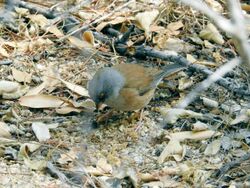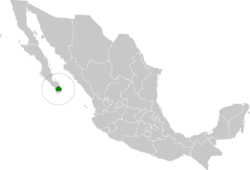Biology:Baird's junco
| Baird's junco | |
|---|---|

| |
| Scientific classification | |
| Domain: | Eukaryota |
| Kingdom: | Animalia |
| Phylum: | Chordata |
| Class: | Aves |
| Order: | Passeriformes |
| Family: | Passerellidae |
| Genus: | Junco |
| Species: | J. bairdi
|
| Binomial name | |
| Junco bairdi Ridgway, 1883
| |

| |
| Synonyms | |
|
Junco phaeonotus bairdi | |
Baird's junco (Junco bairdi) is a species of junco, a group of small, grayish New World sparrows. It is endemic to the forests in the higher elevations of the Sierra de la Laguna mountain range of the southern Baja California peninsula in Baja California Sur, Mexico.
Taxonomy and systematics
While originally described as a distinct species,[2] it was once considered a subspecies of the yellow-eyed junco (Junco phaeonotus) before being recognized as a distinct species again after further research.[3] Within the genus junco, Baird's junco is the outgroup to all other juncos with the exception of the volcano junco, having diverged from other members of the genus more than 350,000 years ago despite retaining a phenotype similar to other North American juncos.[4][5]
Etymology
The type specimens of Baird's junco were collected on February 2, 1883 by Lyman Belding at "Laguna, Lower California" [=Baja California], and it was named for Spencer Fullerton Baird, an American ornithologist and naturalist, by Robert Ridgway, the curator of birds at the United States National Museum at that time.[2]
Description
Baird's junco is approximately average-sized for a New World sparrow, with males being (on average) larger than females and most individuals being approximately 15 centimetres (5.9 in) in length with a mass of approximately 18 grams (0.63 oz).[6][7] Baird's junco have the shortest wings (69 millimetres (2.7 in)) and the shortest tails (62 millimetres (2.4 in)) of any member of the genus Junco, something that is likely correlated to their sedentary, non-migratory nature.[8]
Plumage
Baird's juncos are sexually monomorphic, and adult Baird's juncos have gray heads with black lores, buffy brown backs, wings, and flanks, and paler gray or white throats blending into a pale whitish chest, belly, and vent.[7][6] Some individuals are browner below, with color from the flanks covering more of the undersides.[6] Like other members of the genus junco, the outermost tail feathers are white, giving a distinct white flash when birds fly.[6] Baird's juncos have bright yellow eyes, and dull pinkish to pinkish-horn or yellow-orange bills with a maxilla usually darker than the mandible, giving a bicolored appearance to the bill.[6][7]
Vocalizations
The vocalizations of Baird's junco are quite distinct, and are and are significantly different from other populations of "yellow-eyed" juncos in North America.[9] Baird's junco songs are fairly complex, especially for the genus junco, and consist of longer songs with multiple unique phrases and few repeats of phrases within each song.[9]
Distribution and habitat
Baird's junco is restricted to the higher elevations of the Sierra de la Laguna, Baja California Sur, Mexico, where it nests in pine-oak forests.[6] This species is largely restricted to the higher elevations above 1,500 metres (4,900 ft) where appropriate habitat occurs, but non-breeding individuals do wander lower down, with previous sources considering the bird common above 3,000 feet (910 m) in elevation[10] and more contemporary sources noting records as low as 700 metres (2,300 ft) in elevation.[6] These low elevational records have been attributed to non-breeding individuals, and no significant pattern of elevational migration has been noted.[6]
References
- ↑ BirdLife International (2020). "Junco bairdi". IUCN Red List of Threatened Species 2020: e.T103777087A179973167. doi:10.2305/IUCN.UK.2020-3.RLTS.T103777087A179973167.en. https://www.iucnredlist.org/species/103777087/179973167. Retrieved 18 November 2021.
- ↑ 2.0 2.1 Ridgway, Robert (1883). "Descriptions of some new birds from Lower California collected by Mr. L. Belding". Proceedings of the United States National Museum 6: 154–156. https://www.biodiversitylibrary.org/page/15715065. Retrieved 2 March 2023.
- ↑ Chesser, R. Terry; Burns, Kevin J.; Cicero, Carla; Dunn, Jon L.; Kratter, Andrew W.; Lovette, Irby J.; Rasmussen, Pamela C.; Remsen, J. V. Jr. et al. (2017). "Fifty-eighth supplement to the American Ornithological Society's Check-list of North American Birds". The Auk 134 (3): 751–773. doi:10.1642/AUK-17-72.1. https://zenodo.org/record/1236363/files/article.pdf.
- ↑ Friis, Guillermo; Aleixandre, Pau; Rodríguez‐Estrella, Ricardo; Navarro‐Sigüenza, Adolfo G.; Milá, Borja (2016). "Rapid postglacial diversification and long‐term stasis within the songbird genusJunco: phylogeographic and phylogenomic evidence". Molecular Ecology 25 (24): 6175–6195. doi:10.1111/mec.13911.
- ↑ Milá, Borja; Aleixandre, Pau; Alvarez-Nordström, Sofía; McCormack, John (2016). "More than meets the eye: Lineage diversity and evolutionary history of Dark-eyed and Yellow-eyed Juncos". Snowbird: Integrative Biology and Evolutionary Diversity in the Junco: 179–198. doi:10.7208/chicago/9780226330808.003.0008.
- ↑ 6.0 6.1 6.2 6.3 6.4 6.5 6.6 6.7 Mlodinow, Steven G.; Marrón, Gerardo; del Hoyo, Josep; Collar, Nigel; Marks, Jeffrey S. (23 July 2021). "Baird's Junco (Junco bairdi)". doi:10.2173/bow.yeejun2.02. https://birdsoftheworld.org/bow/species/yeejun2/cur/introduction.
- ↑ 7.0 7.1 7.2 Miller, A. H. (1941). "Speciation in the avian genus Junco". University of California Publications in Zoology 44: 173–434.
- ↑ Arango, Axel; Pinto-Ledezma, Jesús; Rojas-Soto, Octavio; Lindsay, Andrea M; Mendenhall, Chase D; Villalobos, Fabricio (16 August 2022). "Hand-Wing Index as a surrogate for dispersal ability: the case of the Emberizoidea (Aves: Passeriformes) radiation". Biological Journal of the Linnean Society 137 (1): 137–144. doi:10.1093/biolinnean/blac071.
- ↑ 9.0 9.1 Pieplow, Nathan D.; Francis, Clinton D. (2011). "Song differences among subspecies of Yellow-eyed Juncos (Junco phaeonotus)". The Wilson Journal of Ornithology 123: 464–471.
- ↑ Grinnell, J. (1928). "A distribution summation of the ornithology of Lower California". University of California Publications in Zoology 32: 1–300.
Wikidata ☰ Q31872941 entry
 |



